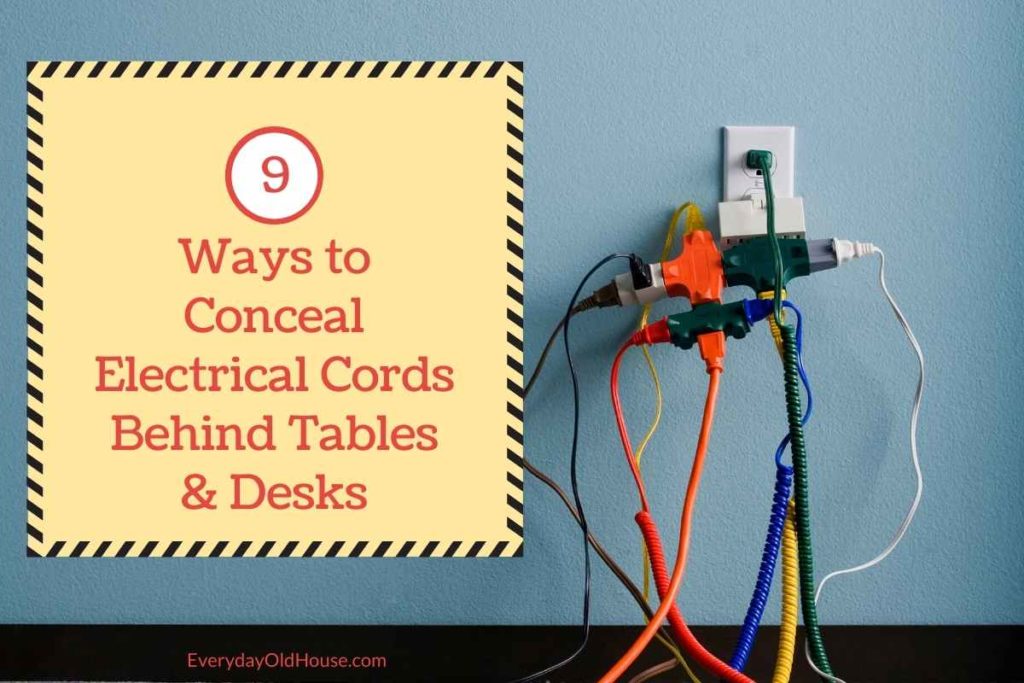As a homeowner, I’ve learned there are two basic things you need to know about your electricity. One, electricity is dangerous. Don’t fiddle around with it unless you know exactly what you are doing. Two, label your home’s electrical panel directory so that it is accurate, complete and legible. And today I’m going to outline my systematic approach to quickly label a home electrical panel directory.
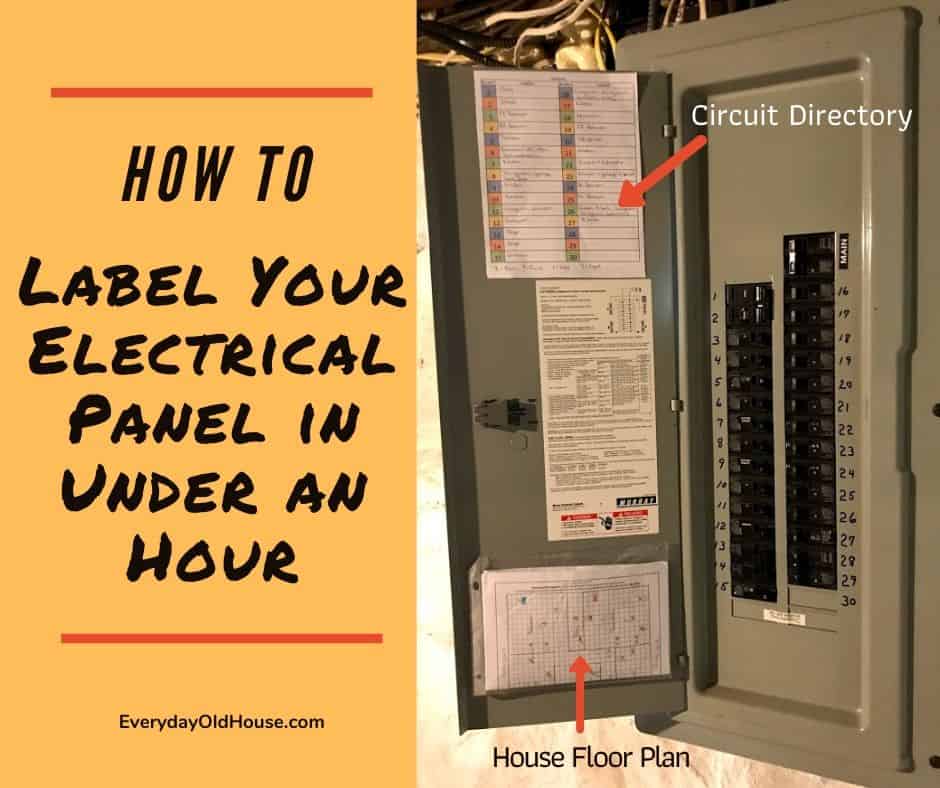
This picture shows how our home’s electrical panel was labeled when we first moved in.

As you can see from the picture, our electrical panel is poorly labeled.
- Some circuit breakers aren’t even labeled.
- Descriptions are too general. For example, circuit breaker #12 notes “Bedroom”. I have 4 bedrooms. Which one???
- Question marks. Circuit breaker #6 and #25 apparently service “? Office” What am I supposed to do with that? First, I don’t even know which room was the office. And second, that question mark doesn’t instill a lot of confidence that even if I knew where the office was, that this circuit even serviced that room.
And I’ll be honest and admit that I didn’t do anything about this directory for 8 years….
But this past weekend I finally stopped dragging my feet and put on my big girl pants. If I’m going to be a responsible homeowner, I should know which circuit breaker powers which parts of my house, right?

I convinced my family to help out and we finally went through the process of properly labeling the circuit breakers in our house. And it wasn’t that bad! Not as boring as tedious as I expected….
Let’s face it, like washing windows and cleaning kitchen cabinets, taking 1-2 hours to label an electric service panel was not exactly the time of my life. But it was necessary.
And this post outlines (in my humble homeowner opinion) the fastest, easiest way to label a home electrical panel. So grab a partner, get it done and go do something else more much fun.
What is an Electrical Service Panel?
Let’s start with the basics. The electrical panel in your home connects the external wire or wires coming in from the street to the internal wires within your home. Think of it as the distribution point where the main electrical wire comes into your home and then splits off into the various wires that service the various rooms of your house.
In other words, every single electrical fixture, switch and plug in your house is connected to a circuit or fuse that runs to your electrical panel (also known as electrical service panel, service panel, fuse box, and circuit breaker panel).
As a side note if you want to dive deeper into how electricity works inside your home, check out this posts on How a Home Electrical System Works.
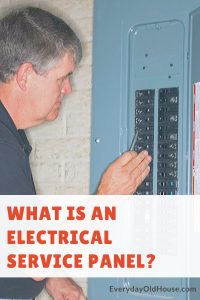
When you open the panel you will see either a series of circuit breakers OR fuses. How do you know which one you have?
- Circuit breakers are rows of switches with toggle levers.
- Fuses are rows of round knobs and screw-in fuses (like lightbulbs)
Historically, fuses existed in homes before circuit breakers. So for my friends who deal with the challenges of owning an old house, you might still have fuses.
But if the electric has been updated or you own a newer house you likely have a circuit breakers.
What’s the purpose of these fuses and circuit breakers? Quite simply, fire prevention and safety. Circuit breakers and fuses interrupt or “break” the power flow if the electrical current in your home spikes to unsafe levels. In plain terms, when the circuit breaker is “tripped” or the fuse is “blown”, it’s your houses’ way of saying ‘Too much! Too much!”
Why do you want these circuit breakers and fuses to work? Quite simply, they prevent your house from burning down. According to the National Fire Protection Association (NFPA):
- Home electrical fires account for an estimated 44,800 fires each year, almost 450 deaths, and 1,250 injuries, and $1.3 billion in property damage.
- Electrical malfunctions are the 3rd leading cause of home structure fires.
As an aside, if you want to learn more about Fire Safety, you might want to check out these posts on Reasons to Check Your Fire Extinguishers and 5 Best Resources to to Prepare a Family Fire Escape.
Why Find and Label a Home Electrical Panel?
Why should you care about where your electrical panel is located? And why do you want the fuses or circuit breakers properly labeled? Two simple reasons: Emergencies and Electrical Work
1. Emergencies
Taking a little time to understand where the electrical wires are distributed throughout your house will pay off plenty with convenience and might help you out in an emergency.
During any kind of emergency, such as a flood or fire, you might need to quickly get to the electric panel and turn off the power. Or if there is a power outage, it helps to know where your circuit breaker or fuse box is beforehand so you aren’t searching in the dark.
Or if you smell something fishy in your home, you might have a burning electrical component. If you suspect an electrical hazard, don’t you want to know exactly where your panel is in order to quickly react in an emergency?
And if the electrical issue is specific to just one outlet, don’t you want to know which breaker it corresponds to? That way you can just shut off that breaker or fuse.
Otherwise, you have to turn off power to the ENTIRE house while you wait for a professional electrician to come and investigate. Because you know this will happen in the night. And then sit in complete darkness until the electrician shows.
2. Electrical Work
If you have the know-how or motivation to do light work on the electrical system on your house, the first thing you must do is cut the power to that outlet. But first you need to know which breaker coordinates with that outlet.
Personally, I’m petrified of electric, But my husband isn’t. He understands basic rewiring and can replace outlet.
And until this weekend, any electrical work always started with him standing in front of the electrical panel, flipping breaker after breaker. Meanwhile I stood next to the outlet and yelled out when the breaker was tripped.
Not exactly how I define spending quality time with my true love….
Or, if no one else was home, he got some cardio in by running up and down stairs to flip breakers and check outlets. And all that stair climbing definitely put him in a good mood ?.
How to Label a Home Electrical Panel
Below are the 7 steps we used to quickly, yet accurately and thoroughly label our home’s electrical service panel.
1. Draw Your House Floor Plan
First draw a floor plan of your house. It’s up to you whether you make your floor plan drawing floor-by-floor or room-by-room per page. It doesn’t have to be too fancy – maybe a few squares and rectangles to designate the walls, and notations of the front and backyard to keep your bearings. In fact, drawing up the floor plan is a great way to involve the kids.

Don’t forget every area of your home that has electric service. That includes the exterior of your house (i.e. plugs on porches, entrance lights, floodlights, etc…), unfinished basements, attics and garages.
For example, we have an older detached garage with an electrical conduit that runs underground. Other easy-to-forget receptacles?
- Furnace
- Washer/dryer
- Electric heaters and water heaters
- Sump pumps
- Security systems
- Wired smoke or carbon monoxide alarms
- Thermostats
- Door bells
Personally, I used a home floor plan template found while preparing my family’s fire escape plan. My initial plan was to dedicate a page per floor.
And that worked fine for the second floor with bedrooms and bathroom. But for the first floor, we have so many outlets and appliances that I needed to dedicate one page just to the kitchen, and another page to the remaining rooms.
2. Find Electrical Connections
Walk around your house with your floor plan and mark all the receptacle in your home. I divided receptacles into: fixtures, outlets and switches. Peek behind furniture situated against the walls to identify any hidden outlets.
Used a simple system to mark up the receptacle types and locations directly on your floor plan, such as:
- Letters: Use F = fixture, O = outlet, S = switch (note that switches are most likely to connect to a wall or ceiling fixture)
- Colors: Use pink highlighters for fixtures, green for outlets and blue for switches
- Symbols: Use triangle for fixtures, circle for outlets and squares for switches
This step is a good opportunity to engage your family. I made a game of it with my oldest elementary school-aged daughter to see who could find the most connections.
3. Where the is Heck is Your Electrical Service Panel?
Finding the electrical service panel is a usually straight-forward exercise. Commonly, a electric service panel is located in a basement, garage, storage room, laundry room, closet or hallway.

But sometimes it’s a bit harder to find. Perhaps it’s hidden due to renovations and additions. Or maybe the panel isn’t even inside the house, but rather located outside.
If after searching, you still can’t find your electric service panel, look around your neighborhood. Is there another house on your block that looks similar? If so, check with a neighbor. Why? If you live in a neighborhood with houses built around the same time, the panels may be in similar locations.
Note that your home might have more than one panel. Sometimes, there’s also a “sub-panel” that controls various circuits in a different area. We have a sub-panel with breakers for kitchen appliances about 20 feet away from the main panel. (Don’t worry about looking for a sub-panel.)
4. Enlist Help
In the early 2000s, did you ever watched the game show Who Wants to Be a Millionaire? If stuck on a question, contestants were allowed to use a variety of lifelines to help find the answer. One of these lifelines was Phone-a-Friend, where contestants could call a friend or relative on the phone.
Do yourself a favor. Phone-a Friend. Enlist a friend or family member for this task. It’s worth buying them a drink or dinner in exchange for their help.
But if you do have to go it solo, consider investing in a circuit finder.
5. Turn Everything On!
There are a few ways to tackling going around your house and mapping your circuits (of fuses) on a floor plan. Personally, I found the least chaotic, most systematic method was to simply go room-by-room. Turn on all ceiling and wall fixtures, lamps, switches, and any electronics.
In other words, turn everything on.
Find ALL Outlets
Chances are you don’t have something plugged into every single outlet in a room. We didn’t. So I carried a nightstand lamp to every room to plug into a unused outlet. I would turn the lamp on, map its circuit, unplug it, and move to the next room.
Any small electronics that are easy to identify when turned on and off – meaning bright lights or noises – will do for this exercise, such as:
- Bedside or work lamp
- Digital clock
- Radio
- Hair dryer
Old Wiring
A quick note here if you own an older home. If you have old wiring, you do run the risk of tripping circuits. For example, we know from experience that running the vacuum when all window air conditioners are on, we trip a circuit.
6. Map Circuits (Fuses) on House Floor Plan
Station your friend at the electoral panel (Person #1 – aka my husband), and the other person in the room (Person #2 – aka my daughter and I).
Depending on how far away you both are, yell or use cell phones (or even your kids’ walkie talkies!) to communicate.

Note that this assumes that your circuits or fuses already have been assigned a number. If not, take a sharpie and write numbers in sequential order down the panel next to the breaker or fuse.
The person by the electrical panel shuts (Person #1) off breaker Number 1. The person in the room (Person #2) then identifies all the fixtures, switches and outlets that shut off (if any) and mark them with a “#1” on the paper room diagram. When done Person #2 communicates to Person #1 to turn breaker Number 1 back on, then turn breaker Number 2.
Repeat until done…
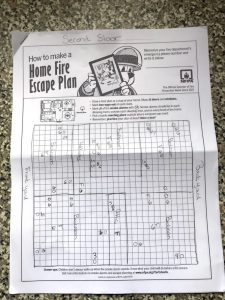
When you finish, every fixture, switch and outlet on your floor plan should have a circuit number next to it.
Not too complicated, right? Admittedly, there is more to it (electric subpanels, dedicated circuits to certain appliances).
But honestly, as the average homeowner, I don’t think it’s essential for me to dive deeper into my home’s electrical systems. Instead, as a responsible homeowner my job is to go through this mapping process and adequately label my electric service panel.
7. Create the Label a Home Electrical Panel Directory
Now you have a map that correlates fixtures, switches and outlets with breaker or fuse number. Note everything that’s on the circuit and transfer your findings to the directory or the individual circuit.
Most electrical panels will have a sticker on the inside door where you can write down the corresponding rooms/areas of the home. If you need a new sticker, Amazon has a few directory options (see bottom of post) or visit the usual big box home improvement stores.
Free Electrical Panel Directory Template (pdf and Excel)
Personally, I didn’t buy a new label. Instead I created a template circuit breaker directory in Microsoft Excel and printed from my computer.
Feel free to download this free pdf version of circuit breaker directory below. It’s large enough to give plenty of room for detailed descriptions, but small enough to easily fit inside a traditional-sized circuit (or fuse) breaker box.
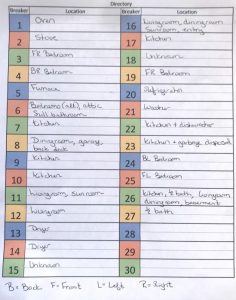
PDF Version
Microsoft Excel Version
Note that there are 2-tabs in the Excel file: 30- and 42- circuit panels to choose from. Also – sometimes the Excel file is finicky and won’t property download. If so, email me and I’ll send it to you directly. I’m a one-woman show, so it might take me a day to get back to you. But I promise I will!
[Interested in a fancier option? GEM Awards reached out to me and offered 20% off their Engraved Electrical Panel Labels by using promo code EVERYDAYOLDHOUSE (I receive no commission, they just seemed super nice). I haven’t used these, so if you do try them, let me know how they are!]
Electrical Panel Labeling Tips
Here’s a few tips for filling in the label for the panel:
1. Make It Permanent and Legible
Let’s face it, once you’ve mapped your home’s circuit breakers, you’ll close the panel door and not open it for a long time (unless you run into problems).
Make sure your label is legible and the writing is permanent. Save yourself from frustration in a few years with a panel labelled with faint or illegible writing. A few tips:
- Use a pen. Don’t use a pencil to label a home electrical panel – it will fade with time.
- If you have nice handwriting, write directly on the label. But if you have chicken scratch for handwriting, use a label maker.
2. Don’t Use Nicknames
Do your home’s next owner a favor and don’t label circuits with nicknames. For example, “My Office” or “Emma’s Bedroom” isn’t going to cut it with the next owner. They aren’t going to know which room the office was, nor know who little Emma was and where she slept.
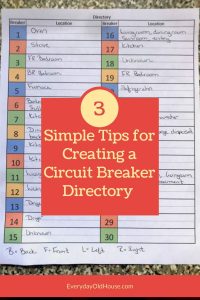
Instead of nicknames, use more general terms and describe a location, like “1/2 bathroom” or “front left bedroom” to help the next owner interpret the electric panel directory.
3. Label Unknowns and Spares
Panels can commonly have breakers or fuses that don’t seem to power anything, especially in old houses. We have a few of those in our house. Consider labeling these mystery breakers as “Spare” or “Unknown” so you know that you tested them and were unsuccessful at identifying their route. And mark these using pencil (versus pen) so that if you do find out where it connects, you can erase and make changes.
8. Mount Directory & House Floor Plan
The last step is to store the directory and house floor plan to the inside of the electrical panel door. Using double-sided tape, secure the directory to the panel door. If your house floor plan is only one page, you can also secure directly to the door. But if your house plan is multiple pages, place inside a clear plastic page protector, and tape the plastic insert to the inside of the electrical panel door.
Here’s the finished product.
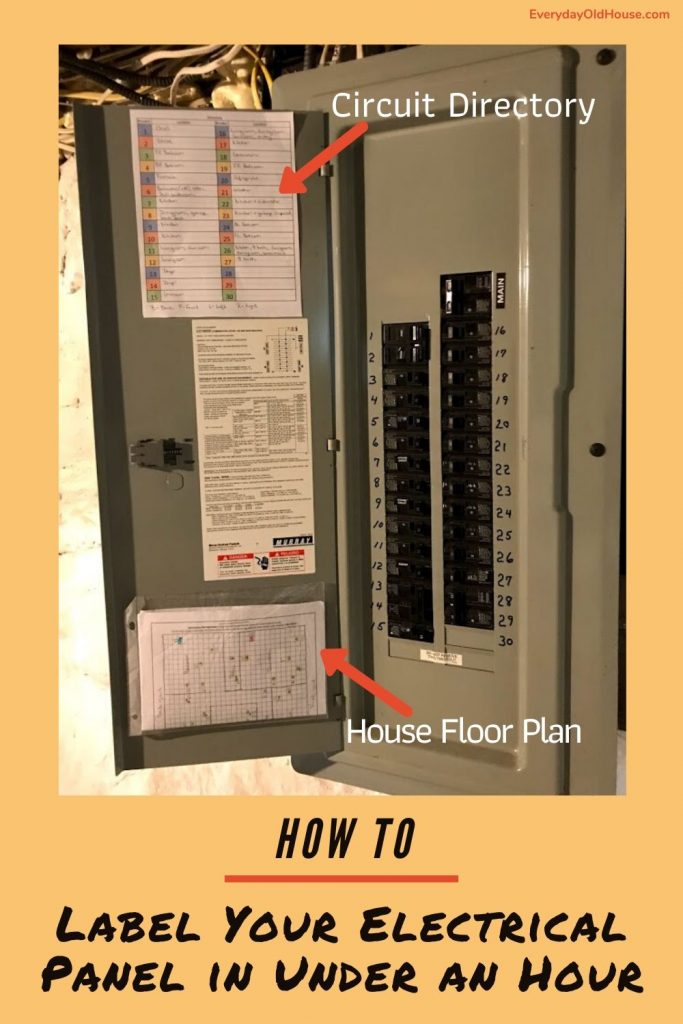
My electric panel directory listing out all the circuit breakers is mounted at the top of the door, and the page protector holding the house floor plans at secured the bottom. It’s a neat and comprehensive snap-shot of our home’s electrical system.
Looking for other ways to Label Your Circuit Breaker? Or a different template (no hard feelings, if so….I just want you to be safe and label your circuit breaker!) Then check out Grammye’s Front Porch.
Related Posts
- Let’s face it, electrical panel doors are not the most attractive wall decor. If so, check out how these 10 bloggers concealed their electrical panel doors and transformed into a focal point of their common areas.
2. Concealing electrical cords behind your tables and desks only takes a few minutes and a few dollars, but can make your house exponentially more tidy! Check out these 9 Easy Ways to Hide Electric Cords Behind Tables and Desks.
Want to be the first to know about new posts? Be sure to follow me on Pinterest, Facebook, Instagram or Twitter of even Etsy! Or better yet… Subscribe below!
My monthly (admittedly sometimes more, sometimes less….) emails are like receiving a unexpected letter from an old friend WITHOUT needing to put on your slippers and walk out to your mailbox…. See? I got ya, my friend!)
[Note: My posts are proudly connected to these amazing link parties full of DIY ideas and inspiration!]

